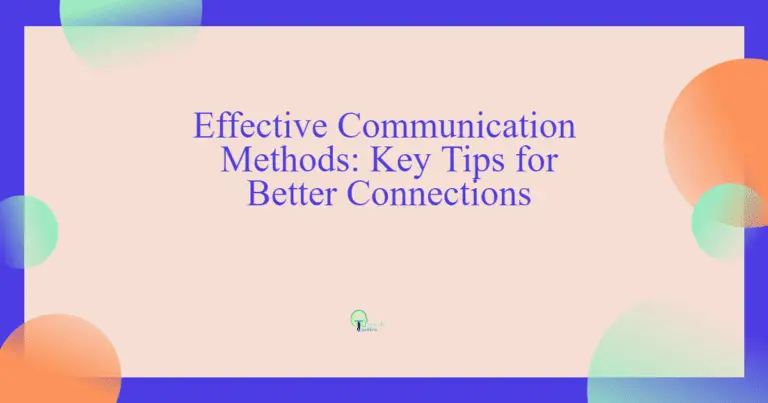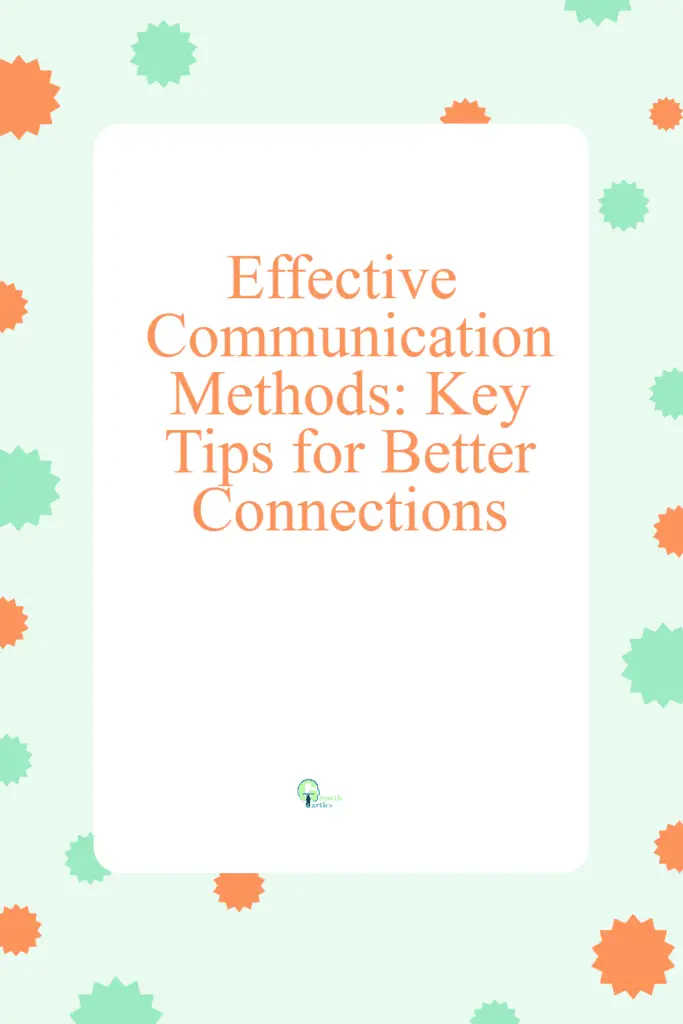Effective communication plays a crucial role in both personal and professional settings. It enables us to establish meaningful connections, convey our thoughts and ideas clearly, and build strong relationships. By utilizing effective communication methods, we can improve our overall understanding, avoid misunderstandings, and promote a positive and collaborative atmosphere. In this blog post, we will explore various strategies and techniques for enhancing our communication skills.
Jump To Section
Types of Communication
There are various types of communication, each with its unique characteristics and purpose. Verbal communication is perhaps the most common and widely used form, involving spoken or written words to convey a message. It allows immediate feedback, clarification, and the ability to express complex thoughts and emotions effectively.
Nonverbal communication, on the other hand, relies on gestures, body language, facial expressions, and eye contact to transmit information. It is used in conjunction with verbal communication and can often provide additional context or emphasis to the spoken word. Nonverbal cues are often subtle but can have a significant impact on the overall message being conveyed. Written communication involves the use of written words to transmit information, ideas, or opinions. It can take various forms, such as emails, memos, letters, reports, or even text messages.
Written communication provides a permanent record that can be reviewed or referred to later, and it allows for careful thought and consideration before expressing oneself. However, it lacks the immediate feedback and ability to convey the tone and emotion that verbal communication offers.
Visual communication is a mode of transmitting information through visual aids such as graphs, charts, diagrams, photographs, or videos. It is particularly effective in presenting complex data, statistics, or concepts in a simplified and easy-to-understand manner. Visual communication can enhance understanding and retention, especially for individuals who are visual learners. It can also transcend language barriers, making it a powerful tool for reaching audiences with diverse linguistic backgrounds.
Lastly, digital communication has become increasingly prevalent in today’s interconnected world. This includes various forms of electronic communication, such as emails, instant messaging, social media platforms, and video conferencing. Digital communication allows for quick and convenient interaction, regardless of geographical distance. It provides opportunities for collaboration, networking, and information sharing on a global scale. However, it can also lead to misinterpretations, misunderstanding, and the loss of nonverbal cues that are critical in face-to-face communication. In summary, communication encompasses various forms, each with its strengths and limitations.
Verbal, nonverbal, written, visual, and digital communication all play a role in our daily lives, and understanding their characteristics can help individuals become effective communicators in different contexts. The ability to adapt and utilize the appropriate form of communication is essential for successful interpersonal relationships, teamwork, and overall social interactions.

Verbal Communication Techniques
Active Listening
Active listening is an essential skill that can tremendously enhance communication outcomes. It involves fully focusing on the speaker, understanding their message, and providing appropriate responses. By practicing active listening, we can foster empathy, demonstrate respect, and encourage open dialogue.
To effectively practice active listening:
- Give your full attention to the speaker, maintaining eye contact and nodding to show your engagement.
- Resist the urge to interrupt or formulate your response while the speaker is talking.
- Paraphrase and summarize what the speaker said to ensure understanding.
- Show empathy by acknowledging the speaker’s feelings or emotions.
Clear and Concise Speaking
Clear and concise speaking is crucial for effective communication, as it enables our message to be easily understood by others. By using simple language and organizing our thoughts, we can avoid confusion and ensure that our ideas are accurately conveyed.
To promote clarity in verbal communication:
- Avoid complex jargon or technical terms; instead, use plain language.
- Organize your thoughts before speaking, ensuring a logical flow of ideas.
- Use appropriate visual aids, such as diagrams or charts, if necessary.
- Speak at a moderate pace, allowing others to process your words.

Non-Verbal Communication Strategies
Body Language
Body language plays a significant role in communication and can greatly impact the message we convey. It includes gestures, posture, and facial expressions that complement our verbal communication. By being aware of our body language, we can align it with our spoken words and enhance the clarity and effectiveness of our message.
Key body language cues for effective communication include:
- Maintaining an open and relaxed posture, avoiding crossed arms or hunched shoulders.
- Make appropriate gestures that support and reinforce your message.
- Using appropriate and responsive facial expressions that convey emotions and engage others.
Facial Expressions
Facial expressions are a vital aspect of non-verbal communication, as they convey emotions and provide additional information to the listener. By using facial expressions consciously, we can enhance the understanding and impact of our message.
To effectively use facial expressions:
- Practice maintaining an open, approachable expression during conversations.
- Be aware of your expressions while speaking and adjust them accordingly.
- Use appropriate facial cues, such as smiling or furrowing your brow, to reinforce your message.
Written Communication Techniques
Email Etiquette
Email is a primary form of professional written communication. Proper email etiquette is crucial to ensure clarity, professionalism, and effective message delivery.
Best practices for professional email communication include:
- Use concise subject lines that accurately summarize the content of the email.
- Address the recipient appropriately and maintain a polite and professional tone.
- Keep the email brief and to the point, using short paragraphs and bullet points if necessary.
- Proofread before sending to eliminate any grammatical or spelling errors.
Clear and Effective Writing
Clear and effective writing is essential in various professional contexts, such as reports, memos, or presentations. It allows our message to be easily understood and prevents misinterpretations.
Tips to improve writing skills for effective communication:
- Plan and structure your writing, ensuring a logical flow of ideas.
- Use appropriate language that is relevant to your intended audience.
- Avoid complex sentence structures and unnecessary jargon.
- Proofread and revise, checking for grammar, punctuation, and clarity.
Technological Communication Tools
Video Conferencing
Video conferencing has become increasingly important for remote collaboration and communication. However, ensuring effective communication during video conferences can be challenging due to technical limitations and potential distractions.
To facilitate effective communication during video conferences:
- Test your equipment and ensure a stable internet connection before the meeting.
- Speak clearly and project your voice to compensate for potential audio issues.
- Use visual aids or screen-sharing features to enhance understanding.
- Pay attention to non-verbal cues, such as facial expressions or body language, as much as possible.
Instant Messaging
Instant messaging is a convenient and efficient method of communication in professional settings. However, it is crucial to streamline your messaging to ensure clear and concise communication.
Strategies for clear and efficient messaging in professional settings include:
- Use brief and specific messages to convey your points effectively.
- Avoid excessive use of abbreviations or slang that may confuse others.
- Respond promptly but respect others’ availability and response time.
- Be mindful of your tone and the context of the conversation.

Cultural Considerations in Communication
Understanding Different Cultural Dynamics
When communicating with individuals from different cultural backgrounds, it is essential to be mindful of cultural differences and adapt our communication style accordingly. This promotes understanding, and respect, and prevents misunderstandings.
Key elements to consider when communicating with people from different cultures include:
- Learn about cultural norms, customs, and etiquette specific to the individuals you are communicating with.
- Practice active listening and ask clarifying questions if you are unsure of a cultural reference or context.
- Avoid making assumptions or stereotypes based on cultural backgrounds.
- Be open to learning and appreciating different perspectives.
Overcoming Language Barriers
Language barriers can impede effective communication, particularly in multicultural environments. However, by employing techniques to overcome these barriers, we can ensure successful communication.
To overcome language barriers:
- Use simple and clear language, avoiding slang or idioms that may be challenging to understand.
- Provide visual aids or context whenever possible to enhance understanding.
- Utilize translation tools or professional interpreters to facilitate conversations if necessary.
- Show patience and understanding while communicating with non-native speakers.
Conflict Resolution and Effective Communication
Active Listening in Conflict Situations
Active listening is a crucial skill in conflict resolution, as it helps to foster understanding, and empathy, and de-escalate tense situations.
Techniques to employ active listening during conflicts include:
- Give your undivided attention to the person expressing their concerns or grievances.
- Allow the person to finish speaking before responding.
- Validate the emotions expressed and show empathy.
- Ask clarifying questions to ensure a thorough understanding of the situation.
Assertive Communication
Assertive communication is an important tool in conflict resolution, enabling individuals to express their needs and concerns while maintaining respect for others.
Strategies to practice assertive communication politely:
- Use “I” statements to express your feelings and perspective without assigning blame.
- Listen actively and empathetically to the other party’s points of view.
- Seek mutually beneficial solutions and compromise where possible.
- Remain calm and composed, avoiding aggressive or passive-aggressive behaviors.
Wrapping Up Our Guide on Methods of Communication
Effective communication is an essential skill for establishing strong connections and fostering understanding in both personal and professional settings. By incorporating strategies such as active listening, clear verbal and written communication, utilizing non-verbal cues, and being culturally sensitive, we can enhance our communication skills significantly. Moreover, these skills are invaluable for conflict resolution and building productive relationships. So, let us prioritize and cultivate effective communication methods to promote growth and success in all areas of life. Communication is a fundamental aspect of human interaction, enabling people to exchange information, ideas, and emotions with one another.


